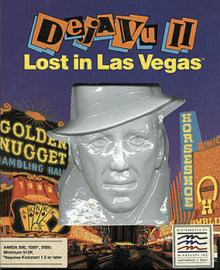Deja Vu II: Lost in Las Vegas
| Deja Vu II: Lost in Las Vegas | |
|---|---|
 Amiga box cover | |
| Developer(s) | ICOM Simulations |
| Publisher(s) | Mindscape |
| Composer(s) | Hiroyuki Masuno (GBC) |
| Engine | MacVenture |
| Platform(s) | Apple IIGS, Macintosh, Atari ST, CD-i, Commodore Amiga, Game Boy Color, PC, Pocket PC |
| Release |
1988 (Mac) 1989 (Amiga, ST, GS) 1990 (MS-DOS) 1999 (GBC) |
| Genre(s) | Adventure |
| Mode(s) | Single-player |
Deja Vu II: Lost in Las Vegas is a point-and-click adventure game, the sequel to Deja Vu: a Nightmare Comes True, set in the world of 1940s hard-boiled detective novels and movies. It was the last game made in the MacVenture series.
Gameplay
In this follow-up set in the late 1940s our hard-boiled hero Theodore 'Ace' Harding once again regains consciousness, this time in a bathroom at the Las Vegas Lucky Dice Hotel and Casino, with his memory intact. It soon becomes apparent that the Vegas mobster Tony Malone is missing a hundred grand ($112,000 to be exact) after the events that took place in Deja Vu (I): a Nightmare Comes True and that Ace has become the scapegoat; he is to return that money within a week or face the classic "or else"; in other words, his death.
Deja Vu II takes place in a sparsely populated Las Vegas reminiscent of the movie Bugsy, with just a few locations to explore. However, the player has the option to take the train to other cities including Chicago (if the player attempts to go to Los Angeles, St. Louis, or New York prematurely, Ace is killed by one of the antagonists, Stogie Martin), where locations from Deja Vu I are revisited. Connections to this background story are well explained, and the game is completely playable by itself. In fact, there are situations where experience with Deja Vu I can be a disadvantage by creating certain expectations, for instance: the phone in the office at Joe's Bar is not openable in Deja Vu I, in Deja Vu II it contains an important item. To get to the office the player has to climb the fire ladder from the street, which is "too high" to reach in Deja Vu I.
There is also a police presence in Deja Vu II, though they are not after Ace directly as in the first game. Here, Ace can be arrested immediately following the player doing some unlawful act in a public location. Examples of offenses are disturbing the peace (by breaking glass or firing a gun) and indecent exposure (not wearing any clothes). An arrest causes the game to be lost as, depending on the crime, either Ace is put on the electric chair or Stogie posts bail and executes Ace in the desert (or at a cemetery if the arrest was in Chicago).
Like the other MacVenture games there is a time limit, in this case the hitman Stogie, who periodically reminds Ace to "come up with the dough". Although no longer affected by drug-induced amnesia (as in Deja Vu I), the player still experiences memory flashbacks when encountering certain environments or photographs.
Together with its predecessor, Deja Vu II is considered by some fans to be the most difficult of these games and requires a lot of lateral thinking. As the player has no hope of returning the lost money in time, the ultimate goal is to find some way out of the situation with the correct evidence. As in Deja Vu I, the gameplay has a final part where evidence collected during the game has to be planted in the right places. This part is among the trickiest in the game, since the significance of each tidbit can be hard to assess. The player must leave evidence of Daniel Ventini's treachery in Tony Malone's office and leave proper evidence of Tony Malone's "awareness" in Daniel Ventini's secret office.
Reception
Computer Gaming World, reviewing the Macintosh version, gave the game a negative review, saying, "Linear text games with "Guess The Commands" are right down on the bottom of my list of boring ways to waste time." An example pointed out in the review is that the command "operate - flashlight" wields the flashlight as a weapon, while "Flashlight - operate - flashlight" is needed to turn it on.[1] Compute! was more positive, stating that Deja Vu had "a quality plot and a clever interface".[2]
See also
References
- ↑ Arneson, Dave (May 1989), "Seems Like Old Times", Computer Gaming World, pp. 36, 50
- ↑ Aycock, Heidi E. H. (September 1989). "You Again?". Compute!. p. 80. Retrieved 11 November 2013.
External links
- Information and download for Mac version
- Information and download for Apple IIGS version
- Deja Vu I & II: The Casebooks of Ace Harding at GameRankings
- Deja Vu I & II: The Casebooks of Ace Harding Review at Adventure Gamers
- Deja Vu I & II: The Casebooks of Ace Harding Review at Game Informer
- Deja Vu I & II: The Casebooks of Ace Harding Review at IGN